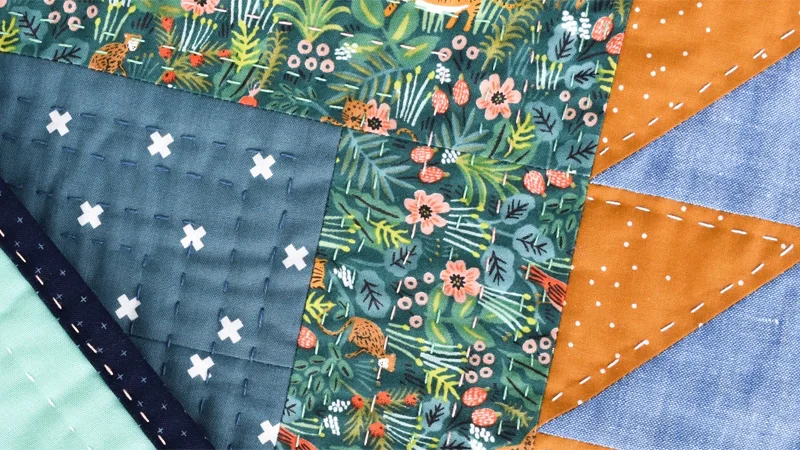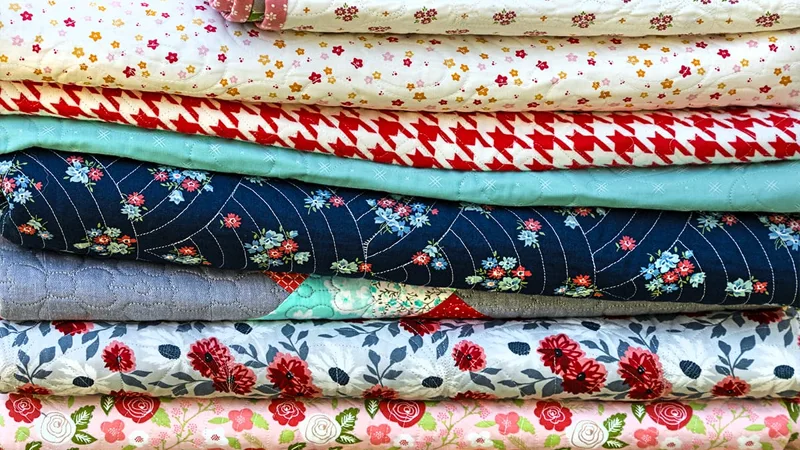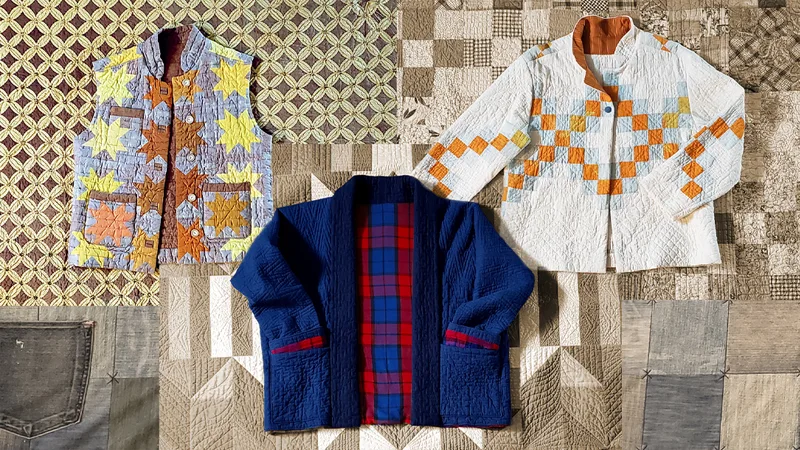Pre Quilted Fabric refers to a type of fabric that has already been quilted or stitched with a layer of batting or padding between two layers of fabric.
This fabric is often used in quilting projects, but its versatility extends beyond traditional quilts to various creative endeavors.
Types of Pre Quilted Padded Fabric

Pre-quilted padded fabric comes in various types, each offering unique textures, patterns, and characteristics. Understanding the different types can help crafters choose the most suitable fabric for their specific projects. Here are some common types of pre-quilted padded fabric:
Cotton Pre-Quilted Fabric:
Cotton pre-quilted fabric is one of the most popular choices due to its softness, breathability, and versatility.
It comes in many prints and patterns, from traditional florals to modern geometrics, making it suitable for various projects, including quilts, garments, and home decor items.
Polyester Pre-Quilted Fabric:
Polyester pre-quilted fabric offers durability, wrinkle resistance, and easy care, making it ideal for projects that require more robust and long-lasting materials.
It often features vibrant colors and bold prints, making it a favorite for fashion-forward garments and accessories.
Nylon Pre-Quilted Fabric:
Nylon pre-quilted fabric is known for its water-resistant properties, making it suitable for outdoor and utility projects such as jackets, bags, and pet accessories.
It is lightweight and offers excellent insulation, providing warmth without bulk, which is advantageous for cold-weather garments.
Flannel Pre-Quilted Fabric:
Flannel pre-quilted fabric is prized for its softness, warmth, and cozy texture, making it perfect for cold-weather projects like blankets, scarves, and pajamas.
It often features classic plaid or checkered patterns, adding a rustic charm to quilts and home decor items.
Fleece Pre-Quilted Fabric:
Fleece pre-quilted fabric is exceptionally soft, plush, and warm, making it ideal for cold-weather garments, accessories, and blankets.
It comes in a variety of thicknesses, from lightweight options suitable for jackets to heavier varieties perfect for blankets and throws.
Decorative Pre-Quilted Fabric:
Decorative pre-quilted fabric encompasses many specialty options, including metallic, embossed, or textured finishes.
These fabrics are often used for embellishments, accents, or statement pieces in quilts, garments, and home decor projects, adding visual interest and dimension.
What Are the Uses of Quilted Fabrics?

1. Home Decor Projects
Pillows and Cushions:
- Utilize pre-quilted fabric to create stylish throw pillows and cushions for sofas, chairs, or beds.
- Experiment with different shapes, sizes, and patterns to complement your home decor theme.
- Embellish with trims, buttons, or embroidery for added flair.
Rugs and Mats:
- Construct durable and cozy rugs or mats using pre-quilted fabric as the top layer and non-slip backing.
- Opt for bold patterns or patchwork designs to add visual interest to your floors.
- Customize the size and shape to fit specific areas in your home, such as entryways or kitchen floors.
Tablecloths and Placemats:
- Craft elegant tablecloths and placemats using pre-quilted fabric for special occasions or everyday use.
- Coordinate with your existing tableware or seasonal decor by selecting complementary colors and patterns.
- Add decorative stitching or trim along the edges for a polished finish.
2. Clothing and Accessories
Jackets and Vests:
- Fashion trendy jackets or vests using pre-quilted fabric for warmth and style.
- Choose a quilted pattern that suits your personal aesthetic, from classic diamond quilting to modern geometric designs.
- Customize with pockets, zippers, or snaps for functionality and versatility.
Bags and Wallets:
- Sew chic handbags, tote bags, or clutch purses using pre-quilted fabric as the main material.
- Select coordinating fabrics for linings, straps, and accents to create a cohesive look.
- Incorporate interior pockets and compartments to keep belongings organized and accessible.
Hats and Gloves:
- Keep warm in winter with cozy hats and gloves crafted from pre-quilted fabric.
- Choose soft, insulating materials for comfort and protection against the elements.
- Embellish with buttons, bows, or appliques for added style and personality.
3. Crafts and Gifts
Quilts and Blankets:
- Create heirloom-quality quilts and blankets using pre-quilted fabric for both the top and backing layers.
- Experiment with patchwork designs, applique motifs, or quilt-as-you-go techniques for endless creative possibilities.
- Personalize with embroidered initials, names, or dates for memorable gifts.
Fabric Toys:
- Delight children with handmade fabric toys made from pre-quilted fabric, such as stuffed animals, dolls, or play mats.
- Incorporate colorful prints and textures to stimulate sensory exploration and imaginative play.
- Ensure safety by securely stitching seams and using child-safe materials for stuffing.
Tote Bags and Shopping Bags:
- Stitch eco-friendly tote bags or reusable shopping bags using pre-quilted fabric for durability and style.
- Reinforce handles and seams to withstand heavy loads and frequent use.
- Customize with pockets, closures, or embellishments to suit individual preferences.
Advantages of Quilted Fabric

Pre-quilted fabric offers a multitude of advantages that make it a popular choice for crafters and DIY enthusiasts. Here are some of the key advantages:
1. Time-saving:
One of the primary advantages of pre-quilted fabric is that it saves time and effort compared to traditional quilting methods.
Since the fabric is already quilted, crafters can skip the time-consuming steps of layering, quilting, and binding, allowing them to focus on the creative aspects of their projects.
2. Consistency:
Pre-quilted fabric ensures consistency in the quilting pattern and stitching across the entire piece, eliminating the need for precise quilting skills.
This consistency is especially beneficial for beginners or those who may struggle with achieving uniform quilting results on their own.
3. Ease of use:
Pre-quilted fabric is user-friendly and accessible to crafters of all skill levels, including beginners.
Crafters can simply cut and sew pre-quilted fabric without the need for specialized quilting equipment or techniques, making it an excellent choice for quick and easy projects.
4. Versatility:
Pre-quilted fabric is highly versatile and can be used for a wide range of projects beyond traditional quilts.
From home decor items like pillows, rugs, and tablecloths to clothing and accessories like jackets, bags, and hats, pre-quilted fabric lends itself to endless creative possibilities.
5. Durability:
Quilting adds an extra layer of padding and stability to the fabric, enhancing its durability and longevity.
Pre-quilted fabric is sturdy enough to withstand frequent use and washing, making it suitable for both functional and decorative items.
6. Insulation:
The padding in pre-quilted fabric provides insulation and warmth, making it ideal for cold-weather garments, blankets, and accessories.
This added insulation ensures comfort and coziness, especially during chilly seasons or in drafty indoor spaces.
7. Design options:
Pre-quilted fabric is available in a wide variety of colors, prints, and textures, allowing crafters to choose the perfect fabric for their projects.
Whether you prefer classic florals, modern geometrics, or novelty prints, there is a pre-quilted fabric to suit every aesthetic and style preference.
How to Sew Quilted Fabric?
Sewing with quilted fabric opens up a world of creative possibilities, allowing you to make a variety of stylish and functional projects. Here’s a guide on how to sew with quilted fabric:
1. Gather Your Supplies:
- Quilted fabric
- Sewing machine with a universal or quilting needle
- Thread
- Scissors
- Pins or clips
- Measuring tape
- Iron and ironing board
2. Choose the Right Project:
- Consider the characteristics of your quilted fabric, such as thickness and pattern, when selecting a project.
- Simple projects like pillows, tote bags, or placemats are great for beginners, while more complex projects like jackets or quilts may require additional skills and techniques.
3. Prepare Your Fabric:
- Pre-wash and iron your quilted fabric according to the manufacturer’s instructions to remove any wrinkles or sizing.
- If necessary, trim the edges of the fabric to ensure they are straight and even.
4. Select the Appropriate Needle and Thread:
- Use a universal or quilting needle in your sewing machine to accommodate the thickness of the quilted fabric.
- Choose a thread color that complements your fabric and project.
5. Cut Your Fabric:
- Measure and mark your quilted fabric according to the dimensions of your project using a measuring tape and fabric marker or chalk.
- Use sharp scissors to cut out the fabric pieces, following your markings precisely to ensure accuracy.
6. Pin or Clip Your Pieces:
- If your project requires multiple fabric pieces, pin or clip them together with the right sides facing each other.
- Use pins or clips to secure the fabric layers in place, especially if you’re working with thicker quilted fabric that may shift during sewing.
7. Sew Your Seams:
- Set your sewing machine to the appropriate stitch length and tension for your fabric.
- Sew along the marked seam lines, backstitching at the beginning and end of each seam to secure the stitches.
- Take your time and sew slowly, especially when sewing through multiple layers of quilted fabric, to ensure smooth and even stitches.
8. Press Your Seams:
- Use an iron set to the appropriate temperature for your fabric to press open or press to the side your seams.
- Pressing your seams helps to flatten them and create a professional-looking finish.
9. Finish Your Edges:
- Depending on your project, you may need to finish the raw edges of your fabric to prevent fraying.
- Options for finishing edges include serging, zigzag stitching, or binding with bias tape.
10. Complete Your Project:
- Once all of your fabric pieces are sewn together, follow the remaining steps of your project instructions to assemble and finish your item.
- Take your time and pay attention to detail to ensure a high-quality finished product.
Conclusion:
Sewing with quilted fabric opens up a realm of creativity, allowing crafters to transform simple fabric into beautiful and functional works of art. From cozy quilts to stylish garments and practical accessories, the possibilities are endless when working with quilted fabric.
Throughout this guide, we’ve explored the steps involved in sewing with quilted fabric, from choosing the right supplies to completing your project with precision and care. Whether you’re a seasoned quilter or a beginner crafter, sewing with quilted fabric offers a rewarding and enjoyable experience.
As you embark on your sewing journey with quilted fabric, remember to embrace your creativity, experiment with new techniques, and enjoy the process of bringing your ideas to life. With practice and patience, you’ll develop the skills and confidence to tackle even the most challenging projects.
So gather your supplies, select your favorite fabric, and let your imagination soar as you explore the endless possibilities of sewing with quilted fabric. Whether you’re sewing for yourself, your loved ones, or for the sheer joy of creating, may your stitches be straight, your seams be smooth, and your projects be filled with love and craftsmanship.
